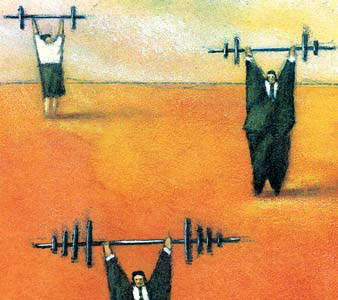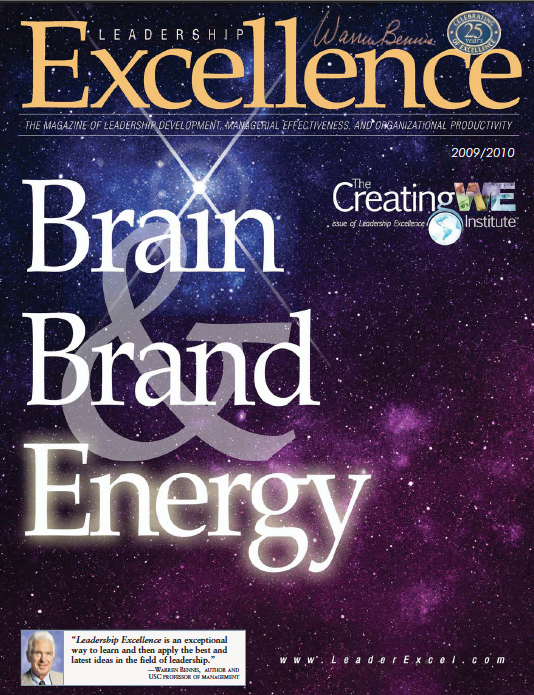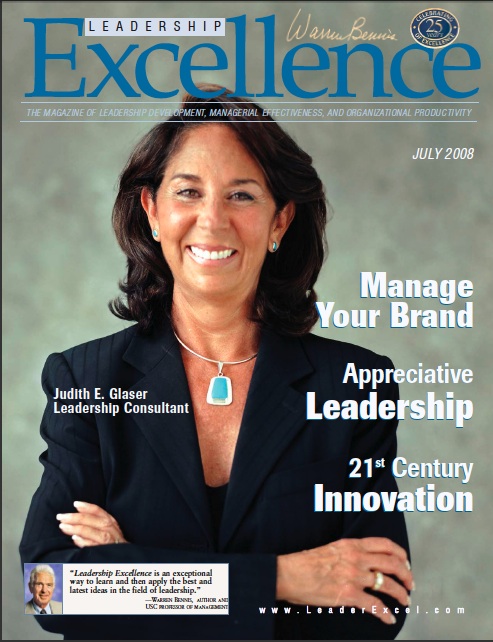By Judith E. Glaser | Leadership Excellence
Published September 2005
First ask seven questions to assess the culture.
WHAT IF WE COULD create organizations where change and transformation were exhilarating and natural and where people were engaged and accountable? Where people acted like owners, working in concert with each other to differentiate their brand and capture the hearts, minds, and souls of the customers?
Executives are trying to make the shift to a collaborative and engaging leadership style that nurtures grows and develops talent and attracts customers.
Many companies invest time and resources into leadership development. Knowing that their success comes through their people, they invest in developing their talent and creating a healthy, committed, and inspired workforce to become a world-class company with staying power.
At the heart of many leadership programs is the desire to help leaders learn how to move from doing it all themselves, to motivating and engaging others to deliver results. Some companies focus on helping leaders to recognize what may cause them to derail and prevent it before it’s too late. Other companies focus on developing their “high potentials” to ensure flow of extraordinary talent. As leader, your job is to help colleagues learn how to work together to handle complexity and change, to think bigger and bolder, and to use feedback to better navigate the terrain.
Imagine, for a moment, that you can trigger potential in your colleagues and set the stage for growth. Imagine that you shape the environment at work in such a way that you see “hidden” talent emerge. What would that workplace look like? And how do you make these changes?
Making CHANGES
When making changes, ask yourself seven questions:
 1. Conversations and language. Are conversations healthy? Do people complain about others behind their backs, or do people have faceto- face healthy discussions about what concerns them? Is there a lot of triangulation (people using others to tell someone what’s on their mind) or can people give direct feedback to others? Is there an ongoing conversation? Are people engaged in working out how to get to the end game, or are people distracted with conversations about whose fault it is that things are not moving forward? Is there a blaming/victim culture or an accountable culture? Is the enterprise being run by fear or hope? Are people connecting emotional states with the conversations taking place? Do people see how their verbal and nonverbal communication impacts the culture ? Do people share a common reality and common language? Can people tell the truth, or is truthtelling painful and hidden?
1. Conversations and language. Are conversations healthy? Do people complain about others behind their backs, or do people have faceto- face healthy discussions about what concerns them? Is there a lot of triangulation (people using others to tell someone what’s on their mind) or can people give direct feedback to others? Is there an ongoing conversation? Are people engaged in working out how to get to the end game, or are people distracted with conversations about whose fault it is that things are not moving forward? Is there a blaming/victim culture or an accountable culture? Is the enterprise being run by fear or hope? Are people connecting emotional states with the conversations taking place? Do people see how their verbal and nonverbal communication impacts the culture ? Do people share a common reality and common language? Can people tell the truth, or is truthtelling painful and hidden?
2. Heart and soul. Is there a spirit of appreciation, or is there a punitive spirit? Do managers complain about poor performance, or are they savvy in the skills that develop talent? Do leaders provide developmental feedback? Do they recognize good work and effort, or only look for what’s wrong? Do leaders always complain about what’s not happening, or do they know how to focus people to create what people want to happen? Are leaders always focusing on problems or do they focus on opportunity?
3. Actualization of vision. Are leaders providing direction? Often the enterprise has a vision and some framework for elaborating the vision, mission, goals, and strategies. However, these constructs are twodimensional with a vision too far out for people to grasp the implications. Too often the guiding principles are on paper, not manifest in everyday life; then breakdowns occur in the execution of the vision. Leaders think they communicate the vision, and so employees should execute it. What’s missing is the interpretation of the vision to help people see “what does it mean to me and what do I have to change to get there.” It also means creating benchmarks for measuring success, and sharing those measures and using them to create a culture of learning.
4. Networks. Are employees collaborating and bonding across boundaries? Clanning naturally takes place when people work together. Its how people cluster together to support each other in the pursuit of goals. Clanning launches the growth of customs and traditions that make up a culture and either strengthen it or weaken it. Some cultures form silos, where groups of people are excluded from others. Healthy teams create effective networks that allow sharing of information, ideas, and best practices through the enterprise and with outside vendors and customers.
The health of the culture depends on the “wellness” of the factions and sub-cultures co-existing and co-creating together. When teams are in conflict, we see excessive gossip, and soon factions are at war. The remedy is to bring the groups together to harmonize or expand their common perspectives.
5. Give and take. In what ways are colleagues engaging with each other for mutual success? An enterprise depends on the sharing of resources, ideas and practices to survive and thrive. As colleagues learn to share, and trust, leaders evolve the capability of sustaining trust in the face of challenges. Less evolved cultures encourage ideation without the processes in place for ideas to develop and mature, thus creating frustration and disappointment. Unmet expectations abound, and employees lose faith in their leaders and in themselves. A mature culture puts into place support systems such as Ideation Centers, and Innovation Centers. Making mistakes is okay in the spirit of discovery. People are rewarded for their efforts to come up with new products and services.
6. Enterprise mind. Is there a feeling that “we’re all in this together?” Are employees and management linked as “one mind?” Or is there fractionation and fragmentation about who we are and what we stand for? Are people thinking and acting from the “I” or from the “We”? Is learning taking place? Are people learning from past mistakes and using them to find new and better strategies? Are people doing this in collaborative teams or are individuals seeking credit for themselves? Is there an enterprise brand? Do employees understand and live the brand? Do they engage with customers about the brand to build its power and magnetism? Is the brand only a logo, or products, or does it engage the hearts, minds, and sprits of employees and customers? What is being done to engage people in living the brand?
7. Spirit. Is there a spirit of discovery and inquiry in the enterprise? Is learning taking place? Are people learning from past mistakes and using them to work better and smarter? Can people let go of the past, and embrace the new? Is everyone working to realize a purpose larger than any one person can encompass alone? Is there recognition of the importance of self-expression and developing leadership points of view? Are leaders pushing their ideas on others (creating an environment of compliance), or are they helping employees to grow their points of view (take ownership and have strong commitment)?
What kind of leader are you? Explore the dynamics of your nature, and address the impact you have on your culture. Create an environment that enables colleagues to be fully engaged and motivated. As you explore the dimensions of your leadership, are you influencing in positive ways and having a profound impact on bottom- and top-line growth, creating a culture that sustains on-going commitment and enthusiasm to achieve your goals?




